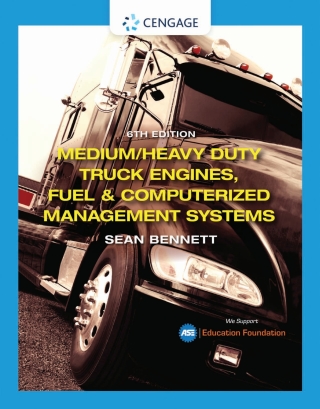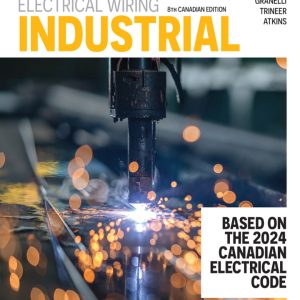Buy Medium/Heavy Duty Truck Engines, Fuel & Computerized Management Systems, 6th Edition PDF ebook by author Sean Bennett – published by Cengage Learning in 2021 and save up to 80% compared to the print version of this textbook. With PDF version of this textbook, not only save you money, you can also highlight, add text, underline add post-it notes, bookmarks to pages, instantly search for the major terms or chapter titles, etc.
You can search our site for other versions of the Medium/Heavy Duty Truck Engines, Fuel & Computerized Management Systems, 6th Edition PDF ebook. You can also search for others PDF ebooks from publisher Cengage Learning, as well as from your favorite authors. We have thousands of online textbooks and course materials (mostly in PDF) that you can download immediately after purchase.
Note: e-textBooks do not come with access codes, CDs/DVDs, workbooks, and other supplemental items.
eBook Details:
Full title: Medium/Heavy Duty Truck Engines, Fuel & Computerized Management Systems, 6th Edition
Edition: 6th
Copyright year: 2021
Publisher: Cengage Learning
Author: Sean Bennett
ISBN: 9780357358641, 9780357358641
Format: PDF
Description of Medium/Heavy Duty Truck Engines, Fuel & Computerized Management Systems, 6th Edition:
Ideal for students, entry-level technicians, and experienced professionals, the fully updated Sixth Edition of MEDIUM/HEAVY DUTY TRUCK ENGINES, FUEL & COMPUTERIZED MANAGEMENT SYSTEMS is the most comprehensive guide to highway diesel engines and their management systems available today. The new edition features expanded coverage of natural gas (NG) fuel systems, after-treatment diagnostics, and drive systems that rely on electric traction motors (including hybrid, fuel cell, and all-electric). Three new chapters address electric powertrain technology, and a new, dedicated chapter on the Connected Truck addresses telematics, ELDs, and cybersecurity. This user-friendly, full-color resource covers the full range of commercial vehicle powertrains, from light- to heavy-duty, and includes transit bus drive systems. Set apart from any other book on the market by its emphasis on the modern multiplexed chassis, this practical, wide-ranging guide helps students prepare for career success in the dynamic field of diesel engine and commercial vehicle service and repair.Important Notice: Media content referenced within the product description or the product text may not be available in the ebook version.
Table of Contents of Medium/Heavy Duty Truck Engines, Fuel & Computerized Management Systems, 6th Edition PDF ebook:
ContentsPrefaceFeatures of the TextSupplementsAcknowledgmentsSection 1: Diesel Engine FundamentalsChapter 1: IntroductionWhy Read This?Commercial Vehicle PowertrainsThe Connected TruckQualifications, Training, and EmploymentCustomer Service and ProfessionalismEngine ID and OEM Market ShareSummaryReview ExercisesChapter 2: Hand and Shop Tools, Precision Tools, and Units of MeasurementWhy Read This?Hand ToolsPrecision Measuring ToolsShop ToolsFastenersFastener Grades and ClassesAdhesives and Chemical Sealing MaterialsThe Metric System and English/Metric ConversionWorkplace OrganizationSummaryReview QuestionsChapter 3: Personal and Safety AwarenessPersonal Protective EquipmentLockout, TagoutWorkplace Hazards and Safety RegulationsEmergenciesOSHASafety HotlinesSummaryReview ExercisesReview QuestionsChapter 4: Engine BasicsWhy Read This?Key Engine TermsThe Diesel CycleThe Two-Stroke Cycle Diesel EngineThe Otto CycleEngine Systems and CircuitsAdvanced Engine TermsSummaryReview QuestionsChapter 5: History of the Heat EngineWhy Read This?History of Motive Power TechnologySummaryReview QuestionsChapter 6: PowerWhy Read This?Definitions and FormulaeEngine Configuration, Engine Speed, and Torsional ForcesHow Much Power Do You Need?SummaryReview QuestionsChapter 7: Engine Powertrain ComponentsWhy Read This?Piston AssembliesPiston RingsConnecting RodsCrankshafts and BearingsRod and Main BearingsVibration DampersFlywheelsSummaryReview QuestionsChapter 8: Engine Feedback AssemblyWhy Read This?Timing GearsCamshaftsValve and Injector TrainsCylinder Head ValvesSummaryReview QuestionsChapter 9: Engine Housing ComponentsWhy Read This?Engine Cylinder BlockCylinder HeadsIntake and Exhaust ManifoldsSummaryReview QuestionsChapter 10: Engine Lubrication SystemsWhy Read This?Engine Lubricating OilLubrication System ComponentsInterpreting Oil AnalysesLubricating Circuit ProblemsSummaryReview QuestionsChapter 11: Engine Cooling SystemsWhy Read This?Engine CoolantCooling System ComponentsRepairing LeaksFiltersCoolant Monitoring CircuitThermostatsCooling FansCooling System ProblemsCooling System ManagementCoolant HeatersSummaryReview QuestionsChapter 12: Engine BreathingWhy Read This?Gas Flow in Breathing CircuitBreathing ComponentsAir Intake System ComponentsTurbochargersCharge Air Heat ExchangersAir-to-Air Heat ExchangersExhaust Gas RecirculationValve Design and BreathingExhaust System ComponentsBreathing Circuit SensorsSummaryReview QuestionsChapter 13: Engine RetardersWhy Read This?Energy Conversion in Air BrakesPrinciples of OperationExhaust BrakesInternal Compression BrakesBus Requests to Engine BrakesSummaryReview QuestionsChapter 14: Servicing and MaintenanceWhy Read This?Startup and Engine Break-InAir Intake System MaintenanceEngine Lube ServiceCooling System ServiceFuel System MaintenanceSelective Catalytic ReductionDiesel Particulate Filter ServiceSummaryReview QuestionsChapter 15: Engine Removal, Disassembly, Cleaning, Inspection, and Reassembly GuidelinesWhy Read This?Service LiteratureRemoval of an Engine from a VehicleEngine DisassemblyCleaning and Inspecting ComponentsEngine Reassembly GuidelinesSummaryReview ExercisesChapter 16: Diesel Engine Run-In and Performance TestingWhy Read This?DynamometersRebuilt Engine Run-In ProcedureChassis Dynamometer TestingEngine Dynamometer TestingOver the Road Break-InSummaryReview ExercisesSection 2: Diesel Fuel SystemsChapter 17: Chemistry and CombustionWhy Read This?Basic ChemistryProperties of Some Common ElementsProperties of Some Mixtures and CompoundsCombustionThe Actual Combustion Cycle in a Diesel EngineSummaryReview QuestionsChapter 18: Diesel Fuel CharacteristicsWhy Read This?Fuel TerminologyPetroleumDiesel Fuel CharacteristicsFuel Storage, Deterioration, and PerformanceSummaryReview QuestionsChapter 19: Fuel SubsystemsWhy Read This?Fuel Subsystem ObjectivesFuel TanksFuel FiltersFuel Charging/Transfer PumpsComplete Fuel CircuitSummaryReview QuestionsChapter 20: Fuel Injection Basics and Governor PrinciplesOverview of Diesel Fuel Injection PrinciplesEngine Management ObjectivesDelivery, Injection, and CombustionGoverning ObjectivesOEM Management SystemsSummaryReview QuestionsChapter 21: Injector NozzlesWhy Read This?Single Orifice NozzlesMultiple Orifice NozzlesElectrohydraulic InjectorsNozzle Testing and ReconditioningNozzle TroubleshootingEHI Testing and ReconditioningSummaryReview QuestionsChapter 22: Port-Helix Metering Injection PumpsWhy Read This?Technical DescriptionInjection Pump ComponentsGovernor Trim DevicesTiming Injection Pumps to an EnginePhasing and CalibrationCritical System Pressure ValuesElectronic Port-Helix MeteringElectronic Pump-to-Engine TimingFuture of Port-Helix Metering PumpsSummaryReview QuestionsChapter 23: Inlet-Metering Rotary Distributor PumpsWhy Read This?Roosa MasterOpposed-Plunger, Inlet-Metering Injection PumpsOpposed-Plunger, Inlet-Metering Pump SummarySummaryReview QuestionsChapter 24: Sleeve-Metering Rotary Distributor PumpsWhy Read This?Sleeve-Metering, Single Plunger Distributor PumpsVE Pump Electronic ControlsSummaryReview QuestionsChapter 25: Single-Actuator EUI SystemsWhy Read This?System OverviewECMEUI OperationCalibration CodesUnderstanding IRTMultiple Injection EventsServicing and DiagnosticsCelect Plus EUIsBench Testing EUIsSummaryReview QuestionsChapter 26: Dual-Actuator EUI SystemsWhy Read This?System OverviewInput CircuitManagement ElectronicsOutput CircuitBench-Testing E3 InjectorsSummaryReview QuestionsChapter 27: HEUI Fuel SystemsWhy Read This?Principles of OperationFuel Supply SystemInjection Actuation SystemHEUI InjectorHEUI Electronic Management and SwitchingHEUI DiagnosticsSummaryReview QuestionsChapter 28: Electronic Unit Pump (EUP) SystemsWhy Read This?System OverviewFuel SubsystemInput CircuitEngine Controllers and Management ElectronicsElectronic Unit PumpsSummaryReview QuestionsChapter 29: Cummins HPI-TPWhy Read This?TP Hydraulic EquationEngine Management ElectronicsFuel System ComponentsOverhead AdjustmentsTroubleshooting ISXSummaryReview QuestionsChapter 30: Common Rail SystemsWhy Read This?What Is CR?CR Subsystems and ComponentsCR Management ElectronicsCR Fuel Routing CircuitDelphi CRDiagnosing CR System ProblemsSummaryReview QuestionsChapter 31: Amplified Common Rail SystemsWhy Read This?ACRS Applications and GenerationsACRS Circuit LayoutACRS HADIACRS Service ProceduresSummaryReview QuestionsSection 3: Engine Management, Alternate Power, Emissions, and DiagnosticsChapter 32: Review of Electrical and Electronics FundamentalsWhy Read This?Atomic Structure and Electron MovementConductors and InsulatorsCurrent FlowMagnetismElectromagnetismElectrical Current Characteristics and Sources of ElectricityElectrical Circuits and Ohm’s LawCapacitanceCoils and TransformersSemiconductorsTesting SemiconductorsPhotonic DevicesUsing Electronic SignalsConclusionSummaryReview QuestionsChapter 33: Vehicle Computer SystemsWhy Read This?Engine ControllersInput CircuitECMS and the Processing CycleOutput CircuitECM ProgrammingEngine Management SystemsBody ControllersSummaryReview QuestionsChapter 34: ESTs and SISsWhy Read This?Development of ESTsDigital MultimetersGeneric ESTConnecting OEM ESTs to the Data BusElectronic TroubleshootingData Bus Codes and ProtocolsHD-OBDGeneric SISs, ESTs, and Diagnostic SoftwareInterpreting Dash Warning LightsSummaryReview QuestionsChapter 35: Electrical Wiring, Connector, and Terminal RepairWhy Read This?SAE Wiring StandardsConnector Assembly and RepairSplicing GuidelinesCircuit Protection DevicesRelaysTroubleshooting TechniquesSummaryReview QuestionsChapter 36: MultiplexingWhy Read This?Multiplexing, Clients, and ServersMultiplexing BasicsAccessing the Data BusDiagnosing Bus FaultsSummaryReview QuestionsChapter 37: The Connected VehicleWhy Read This?Communications MediaVehicle NavigationVideoTelematicsElectronic Logging DevicesCybersecuritySummaryReview QuestionsChapter 38: Natural Gas, Propane, and Biodiesel FuelsWhy Read This?BiodieselMethane FuelsCompressed and Liquid NGIgniting NGFMVSS 304 PrecautionsLiquefied Petroleum GasAlcohol-Based Fuels (Methanol/Ethanol)Fuel Alternatives for EnginesSummaryReview QuestionsChapter 39: High Voltage ElectricityDefinitionsUnderstanding Electrical EnergyGeneral HV SafetyHigh Voltage TestingWelding on HV VehiclesBattery SafetySummaryReview QuestionsChapter 40: Hybrid and Hydrogen Fuel Cell DrivetrainsWhy Read This?Hybrid Electric VehiclesHydraulic HybridsFuel CellsSummaryReview QuestionsChapter 41: Electric PowertrainsEmergence of CEVsSources of ElectricityOverview of CEV ComponentsRechargeable Electricity Storage SystemsTraction MotorsElectric Power Management SystemCharging CEVsCEV Preventative MaintenanceSummaryReview QuestionsChapter 42: Bosch EDC SystemsWhy Read This?Bosch Diesel SystemsEDC Management LogicBlock DiagramsMaking the ConnectionSummaryReview QuestionsChapter 43: Caterpillar Engine Management SystemsWhy Read This?ACERTADEM ElectronicsInput CircuitECMSystem Diagnostics and CommunicationsSummaryReview QuestionsChapter 44: Cummins Management SystemsWhy Read This?Management SystemsElectronic EnginesInput CircuitElectronic Control Module (ECM)Programmable FeaturesSystem Troubleshooting and Engine TestingSummaryReview QuestionsChapter 45: Detroit Diesel Electronic Controls (DDEC)Why Read This?Management SystemsSoftware ToolsDD Electronic Service ToolsInput CircuitProgramming OptionsDiagnostic ToolsDDEC FeaturesSummaryReview QuestionsChapter 46: Navistar Diamond LogicWhy Read This?Navistar Engine LineupDiamond Logic ControlsECM DiagnosticsSummaryReview QuestionsChapter 47: Paccar Engine Management SystemsWhy Read This?Paccar Engine LineupPaccar ElectronicsSystem Diagnostics and CommunicationsPaccar Exhaust AftertreatmentSummaryReview QuestionsChapter 48: Volvo and Mack Engine ManagementWhy Read This?Electronic Engine FamiliesV-MAC and Vectro ElectronicsProgramming and DiagnosticsSummaryReview QuestionsChapter 49: Emissions ManagementWhy Read This?PollutantsEPA Certification TestingDiesel Engine Emissions ControlsDiesel Particulate Filters (DPFs)Selective Catalytic Reduction (SCR)Meeting Chassis GHG Reduction StandardsSummaryReview QuestionsChapter 50: Servicing and Maintenance of Exhaust Aftertreatment SystemsWhy Read This?Visible Smoke Emission: Legacy EnginesExhaust Gas Recirculation (EGR) SystemsDiesel Particulate Filters (DPFs)Selective Catalytic Reduction (SCR)Emissions TamperingField Testing of Smoke DensityAftertreatment Device Removal and ReplacementAftertreatment System ElectronicsSummaryReview QuestionsChapter 51: Failure AnalysisWhy Read This?Structured Failure AnalysisPrinciples of Failure AnalysisComponent FailuresCommon Abuses of Engines and Fuel SystemsSummaryReview QuestionsChapter 52: Troubleshooting and DiagnosticsWhy Read This?Troubleshooting ToolsExhaust AnalysisTroubleshooting GuidelinesQuick Reference Diagnostic ChartsTechnical SupportHD-OBDSummaryReview QuestionsList of AcronymsGlossaryAppendix A: Quick Conversion FormulasAppendix B: J1939 Message DecoderAppendix CAppendix DIndex





